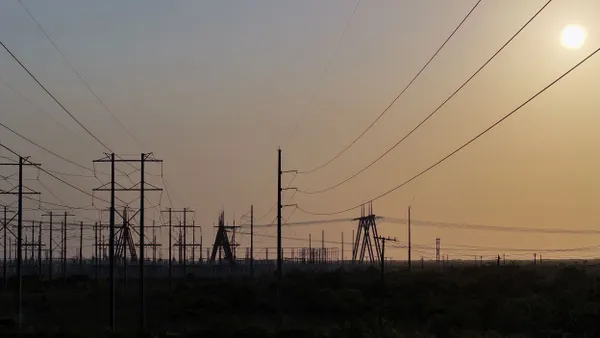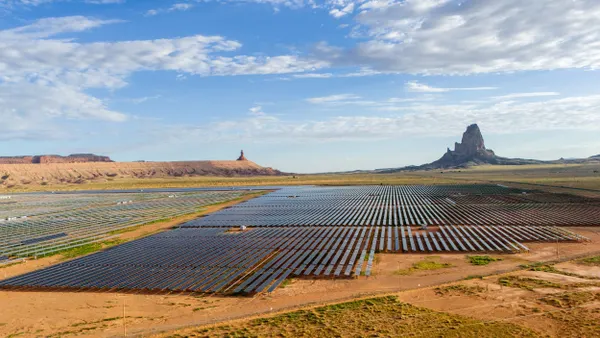Dive Brief:
-
The U.S. Department of Energy this weekend issued an order allowing additional dispatch of three natural gas-fired plants in the California Independent System Operator's (CAISO) footprint through the end of the week, if needed, in light of "exceptional levels of electricity demand" spurred by a heatwave in the state.
-
The order comes after CAISO on Sunday requested leeway on environmental and air quality permit limitations for the plants, due to high electricity demand forecasts this week. The order would allow the system operator to dispatch up to 100 MW of additional generation.
-
The DOE order's scope pales in comparison to the thousands of megawatts of voluntary conservation that enabled California to keep its lights on over the weekend, but it's still a wake-up call, said Ralph Cavanagh, energy co-director of the climate and clean energy program at the Natural Resources Defense Council. "We do not, going forward, want to have to scramble in this way, and we certainly don't want to have to override environmental constraints" to maintain reliability, Cavanagh said.
Dive Insight:
The DOE's order, penned by Assistant Secretary for Electricity Bruce Walker, would allow CAISO to dispatch generation from three plants in the Los Angeles region, if needed to meet demand through Sept. 13, between 2 p.m. and 10 p.m. each day. The system operator will have to submit a report to the agency detailing when the facilities were operated and the estimated nitrogen oxide, ammonia, and other emissions that resulted.
"This strikes me as a one-off, as an example of the CAISO leaving no stone unturned in its determination to maintain reliable service during truly horrific conditions," Cavanagh said. However, Cavanagh said he would be concerned if it were to become a routine part of the strategy for maintaining electric service.
California experienced its second heat wave of the summer over the weekend, with electricity demand forecasts soaring due to the high temperatures at the same time that wildfires across the state posed a threat to power lines. On Saturday, the grid operator issued a Stage 2 emergency — signifying the need for the ISO to intervene in the market — after the fires took out around 1,600 MW of resources. Another emergency was declared on Sunday after 260 MW of generation tripped offline, and an additional 900 MW of capacity was lost on a transmission line from Oregon. However, CAISO was able to avoid initiating rolling blackouts due in part to consumer conservation efforts.
CAISO last month initiated rolling blackouts over two days due to a series of events, including high demand, the lack of available imports and the loss of certain generation resources, among others.
The state's grid troubles essentially stem from an old-fashioned problem, Cavanagh said — the lack of adequate reserves under long-term contract, which put the state in a "short position" when the entire Western grid came under stress.
"We need more and better coordinated long-term procurement of reserves," Cavanagh said, adding that another lesson learned over the last couple of weeks is the need to double down on energy efficiency and demand response initiatives.
The rising demand also prompted CAISO to instruct all the generators in its footprint to ramp up to maximum production capacity during specific times of the day, even allowing them to exceed their interconnection capacity where safe to do so. But the operator of the three natural gas facilities — the El Segundo Energy Center, Walnut Creek Energy Park and Long Beach Generating Station — informed the system operator over the weekend that it could not hit maximum capability without going above federal air quality and other limitations, CAISO President and CEO Steve Berberich said in his request to the DOE on Sunday.
And while California Gov. Gavin Newsom last week issued an emergency proclamation suspending certain state and local permitting requirements for electric generators, that order did not affect federal requirements.
Berberich requested that the DOE issue an immediate order allowing the natural gas facilities to produce additional energy, if directed to by CAISO, notwithstanding federal limitations on nitrogen oxide emissions, ammonia releases, and other regulations. The request was not made lightly, Berberich wrote, and CAISO is aware of the importance of the environmental permit limits.
"However, in the CAISO's judgment, the loss of power to homes and local businesses in the areas affected by curtailments present a greater risk to public health and safety than the limited departures from those permit limits the CAISO requests here," he said.
While CAISO did not initiate rolling blackouts over the weekend, approximately 172,000 customers in Northern California lost power due to a different reliability-related issue — Pacific Gas & Electric's (PG&E) public safety power shut-off program. The utility turned off power to portions of 22 counties in its service territory after forecasting weather conditions that increase the risk of wildfires.
The utility will begin patrolling its lines and restoring power after the weather conditions subside, it said in a press release, likely to be Wednesday.













